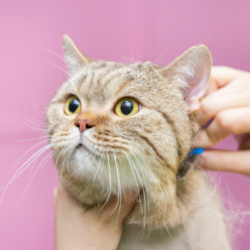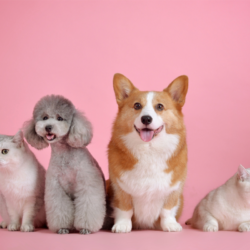All of us pet lovers ask ourselves this question during periods of intense heat: How can I keep my pet cool? In this article, we explore different methods and strategies for keeping your pet cool during the hot summer months.
How do animals regulate their temperature?
Temperature regulation in animals is a complex and fascinating process. For example, dogs, unlike humans, don’t sweat to cool down. They regulate their temperature mainly by panting, a process that allows water to evaporate from their lungs, cooling their bodies. Cats , on the other hand, lick their fur, creating a layer of water which, as it evaporates, helps them to cool down.
That said, each species has its own thermoregulation mechanisms. Birds, for example, spread their wings and pant, while rabbits use the blood vessels in their large ears to disperse heat.
Factors affecting animals’ ability to regulate heat
A number of factors can affect an animal’s ability to regulate its temperature. For example, age, state of health and breed can all play a role. Older animals and those with certain health conditions may have more difficulty regulating their temperature.
Short-nosed breeds, such as bulldogs and pugs, often have difficulty cooling themselves by panting, making them particularly sensitive to heat. The environment also plays a crucial role. For example, a humid environment makes evaporation, a key temperature regulation process, more difficult. Similarly, access to shade and cool water can greatly help an animal to cool down.
Finally, the animal’s physical condition is also important. An overweight or obese animal will find it harder to cool down because body fat acts like insulation, trapping heat inside the body. Understanding these mechanisms and factors is crucial to helping our pets stay cool during the hot months.
How can I tell if my dog is too hot?
It’s essential to keep a close eye on your dog in hot weather to detect signs of overheating. Here are some indicators to look out for:
- Excessive panting: If your dog is panting abnormally and persistently, this may indicate that he’s having trouble regulating his body temperature.
- Excessive salivation: Excessive, drooling salivation can be a sign of thermal distress.
- Agitation: If your dog seems agitated, nervous or uncomfortable, this may be due to excessive heat.
- Weakness or lethargy: Overheated dogs may become weak, lethargic and have difficulty moving around.
- Vomiting or diarrhoea: These symptoms can also occur with overheating.
- Red gums and tongue: Abnormal discolouration of the gums and tongue may be a sign of overheating.
If you notice any of these signs in your dog, it’s essential to take immediate steps to cool him down. Move him to a cooler place, give him fresh water to drink, wet his body with water at room temperature (not cold), and consult a vet immediately if symptoms persist.
Prevention is the best approach, so make sure you follow the advice on keeping your dog cool during the warmer months and keep a close eye on his well-being.
Why is heat a problem for our pets?
It’s important to know that heat is a problem for our pets because they can’t cool down as effectively as humans. Unlike us, they don’t have the ability to sweat all over their bodies. What’s more, their fur, while offering some protection from the sun, can also trap heat.
Effects of heat on our pets’ health
Heat can have harmful effects on our pets’ health. As well as heat stroke, which can be fatal, heat can also cause severe dehydration and damage to internal organs.
Signs of heatstroke in pets
Heat stroke in pets can manifest itself in different ways. Some signs to look out for include excessivepanting, excessive salivation, restlessness, weakness, vomiting and even convulsions. If you suspect heatstroke in your pet, it’s essential to cool it down quickly and consult a vet immediately.
Tips for keeping your pet cool
There are several ways to keep your pet cool during the hot months. First, make sure your pet has constant access to fresh water. You can also use cooling mats or cushions, fans and even air conditioning to help cool his environment.
How can I make sure my pet doesn’t suffer from the heat at home?
It’s essential to keep your home as cool as possible for your pet. Using fans or air conditioning can be a great help. Also, make sure your pet always has a cool place to retreat to, such as a cool tile floor in the bathroom or kitchen.
Coping with the heat outdoors: What can I do to make sure my pet doesn’t suffer from the heat?
Outside the house, it’s essential to protect your pet from the heat of the sun. Try to limit walks and exercise to the cooler times of the day, such as mornings and evenings. Also, make sure your pet has access to shade and fresh water at all times.
Cool games for your pet
Games such as “ice cube chasing” or frozen chew toys can help cool your pet down and entertain it at the same time. And for dogs, a small paddling pool can provide welcome relief from the heat.
How can you protect your pets from the heat?
Of course, here are the specific tips for each type of pet in table form:
| Type of Pet | Advice for Heat |
|---|---|
| Dogs | – Always have fresh water available. |
| – Limit walks to cooler hours. | |
| – Use cooling mats for dogs. | |
| – Never leave your dog in a hot car. | |
| Cats | – Make sure there’s a source of fresh water. |
| – Maintain a cool indoor environment. | |
| – Offer a cloth-covered bottle of frozen water. | |
| – Create shaded areas in the garden. | |
| Birds | – Provide fresh water in their cages. |
| – Avoid direct sunlight on the cage. | |
| – Spray the birds lightly with water at room temperature. | |
| – Watch for signs of overheating. | |
| Other animals | – Seek species-specific advice. |
By following these recommendations for the type of pet you have, you can help ensure their comfort and safety during hot weather.
The importance of hydration
Hydration is crucial to helping your pet regulate its body temperature. As well as providing fresh water at all times, you can also encourage your pet to drink by adding herbs to its water or offering ice-cold treats.
Why is hydration so important?
Hydration is important because it helps to cool the body from the inside out. What’s more, good hydration helps prevent dehydration, which can quickly become a serious problem in the hot months.
How can you encourage your pet to drink more water?
There are several ways to encourage your pet to drink more water. For example, you can try changing the water in his bowl regularly to keep it fresh and appealing. Some pets also prefer running water, so you might consider investing in a pet water cooler.
Feeding in the warmer months
Your pet’s diet can also play a part in its ability to cope with the heat. For example, wet food, which contains a large amount of water, can help increase his water intake.
The impact of diet on heat regulation
Your pet’s diet and transit state can have an impact on its ability to regulate body temperature. For example, a diet high in fat can make it harder for your pet to cool down, as fat acts as an insulator, trapping heat in the body.
What foods can help your pet cool down?
Certain foods can help cool your pet down. For example, fresh fruit and vegetables (always served properly and safely) can provide an extra source of hydration. You can also try serving your pet chilled wet food for a refreshing snack.
FAQ
- How can I make sure my dog doesn’t suffer from the heat?
Keeping your dog comfortable during periods of intense heat is not an insurmountable task. First of all, make sure he has constant access to fresh water. Also, avoid walking your dog during the hottest part of the day. You can also invest in cooling mats for your dog or even make him a little ‘footbath’ in a basin of water.
- How can I cool my cat down in summer?
Just like dogs, cats need constant access to fresh water. Also, make sure your home stays cool, using fans or air conditioning if necessary. Another tip is to freeze a bottle of water and cover it with a cloth. Place it where your cat likes to rest to give it a cool spot.
- How do I know if my pet is suffering from heatstroke?
Certain signs may indicate that your pet is suffering from heat. He may show signs of agitation, weakness, excessive panting, vomiting or even diarrhoea. If you notice these symptoms, it’s important to cool your pet down and consult a vet.
- Can I shave my pet to help it cope with the heat?
It’s not generally advisable to shave your pet completely, as their coat protects them not only from the cold, but also from the heat and the sun. However, shearing can be useful for long-haired pets. Always consult your vet before taking such a decision.
- Does my pet need sun cream?
Like humans, some pets may need sun protection, especially those with light skin or fine coats. There are specific sun creams for pets. However, it’s always best to limit your pet’s direct exposure to the sun during peak hours.
Remember that heat affects our pets as much as it does us, if not more. Following the advice in this article means caring for your furry friend responsibly and with empathy. Every effort, no matter how small, to ensure your pet’s well-being in summer is an affirmation that yes, it is entirely possible and necessary to face up to the question: How can I make sure my pet doesn’t suffer from the heat?







